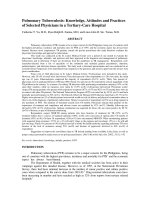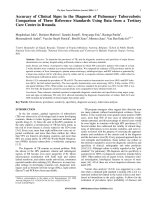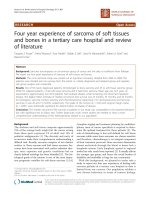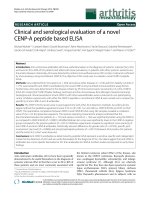Clinical and serological diagnosis of Chikungunya fever in a tertiary care centre of Bihar, India
Bạn đang xem bản rút gọn của tài liệu. Xem và tải ngay bản đầy đủ của tài liệu tại đây (136.04 KB, 4 trang )
Int.J.Curr.Microbiol.App.Sci (2019) 8(9): 943-946
International Journal of Current Microbiology and Applied Sciences
ISSN: 2319-7706 Volume 8 Number 09 (2019)
Journal homepage:
Original Research Article
/>
Clinical and Serological Diagnosis of Chikungunya Fever
in a Tertiary Care Centre of Bihar, India
Richa Sinha, Ratnesh Kumar* and S.N. Singh
Department of Microbiology, Patna Medical College, Patna, Bihar, India
*Corresponding author
ABSTRACT
Keywords
Chikungunya fever,
Conjunctival
congestion, Joint
pain, CHIKV
infection and IgM
ELISA
Article Info
Accepted:
15 August 2019
Available Online:
10 September 2019
Chikungunya fever is caused by an arbovirus belonging to the Alphavirus genus of the
Togaviridae family. It was first isolated in the Newala district of Tanzania in 1952–1953.
Chikungunya virus is no stranger to the Indian subcontinent. It was first reported from
Calcutta (Kolkata now) and was responsible for about 200 mortality3. Since then several
outbreaks of Chikungunya fever have been documented from different parts of India.
Chikungunya virus is transmitted to humans by Aedes mosquitoes. Chikungunya virus
infection is characterized by abrupt onset of fever, headache, rash, nausea, vomiting,
myalgia and arthralgia. This retrospective study was carried out in Department of
Microbiology, PMCH, Patna over 9 months. All the suspected cases with symptoms
indicative of chikungunya fever visiting our department were included in our study.
Confirmation of cases was carried out by detection of CHIKV IgM antibodies in serum
using IgM Antibody capture ELISA Kit (NIV, Pune, India). Demographic details and
clinical complaints of the patients coming positive for chikungunya were noted. Out of 226
serum samples, 72 (31.85%) were IgM positive. Largest group (44.44%) of the patients
belonged to the age group 20-40 years, followed closely by 0-20 years. Among the 72
positive case, 44 (61.1%) were male and 28 (38.88%) were female. Most of the cases
(77.77%) occurred in the month of September followed by August (16.66%). Majority of
the positive cases were from urban areas.
the Indian subcontinent. It was first reported
from Calcutta (Kolkata now)2 and was
responsible for about 200 mortality3. Since
then several outbreaks of Chikungunya fever
have been documented from different parts of
India including Vellore, Chennai (then called
Madras) in Tamil Nadu, and Puducherry (then
called
Pondicherry),
Visakhapatnam,
Rajahmundry, and Kakinada in Andhra
Pradesh, Nagpur, and Barsi in Maharastra4.
Introduction
Chikungunya fever is caused by an arbovirus
belonging to the Alphavirus genus of the
Togaviridae family. It was first isolated in the
Newala district of Tanzania in 1952–19531. It
has become an important global health threats
and has spread from their original niche in
sub-Saharan Africa to most areas of the
world. Chikungunya virus is no stranger to
943
Int.J.Curr.Microbiol.App.Sci (2019) 8(9): 943-946
Chikungunya virus is transmitted to humans
by Aedes mosquitoes. Although both Aedes
aegypti and A. albopictus mosquitoes are
prevalent in India, the predominant vector is
the urban, peri-domestic, Aedes aegypti
mosquito, which is responsible for large-scale
out- breaks5. Chikungunya virus infection is
characterized by abrupt onset of fever,
headache, rash, nausea, vomiting, myalgia
and arthralgia. The joint pain caused by
CHIKV infection is severe and may limit the
simple daily activities6. The disease may be
confused with Dengue, O’nyong-nyong or
Sindbis
virus
infection.
The
word
chikungunya comes from the Bantu language
of the Makonde ethnic group from Tanzania
and Mozambique which refers to the curved
position of the patient due to debilitating joint
pain. This is a self-limited infection and
symptoms usually resolve within one–two
weeks. However, this polyarthralgia is
recurrent in 30–40% of infected individuals
and may persist for years.
Kit (NIV, Pune, India). Demographic details
and clinical complaints of the patients coming
positive for chikungunya were noted. Other
investigations like IgM ELISA for Dengue,
IgM ELISA for JE were carried out as
requested by the concerning clinician.
Statistical analysis
Data were entered in an excel file and
analyzed using Stata 9.2 (College Station Tx,
USA). Clinical and epidemiological features
were studied in Chikungunya positives.
p<0.05 was taken as significant.
Results and Discussion
A total of 226 patients with clinical suspicion
of Chikungunya presented to Department of
Microbiology, PMCH, Patna from January
2017 to September 2017. Serum from each
sample was separated. On all the serum
samples, IgM ELISA (NIV, Pune) for
Chikungunya was done. Out of 226 serum
samples, 72 (31.85%) were IgM positive
(figure 1). Largest group (44.44%) of the
patients belonged to the age group 20-40
years, followed closely by 0-20 years (figure
2). Among the 72 positive case, 44 (61.1%)
were male and 28 (38.88%) were female
(Figure 3). Male: female ratio was 1.57: 1.
There has been considerable morbidity
reported in recent years in India due to
chikungunya, but the actual disease burden is
much higher due to potential underestimation
from lack of accurate reporting. Due to
paucity of literature about incidence, clinical
profile,
atypical
manifestations
and
complications of the Chikungunya from
Northern India we carried out a study on
diagnosing
and
analysing
various
manifestations of Chikungunya cases at Patna
Medical College and Hospital (PMCH) Patna.
Most of the cases (77.77%) occurred in the
month of September followed by August
(16.66%). No positive cases were reported in
the month of January, April and May (figure
3). Majority of the positive cases were from
urban areas, maximum (68%) reported from
Patna district (figure 4).
Materials and Methods
This retrospective study was carried out in
Department of Microbiology, PMCH, Patna
over 9 months. All the suspected cases with
symptoms indicative of chikungunya fever
visiting our department were included in our
study. Confirmation of cases was carried out
by detection of CHIKV IgM antibodies in
serum using IgM Antibody capture ELISA
Common clinical complaints noted in
chikungunya patients were fever, conjunctival
congestion, joint pain, headache, rash and
pruritus (figure 5). Rashes in these patients
were erythematous and maculopapular. Joint
pain was mainly of lower limbs.
944
Int.J.Curr.Microbiol.App.Sci (2019) 8(9): 943-946
As dengue and chikungunya infections elicit
similar symptoms and can be present in the
same locations, clinical differentiation may be
difficult. In Bihar, it was found that the major
chikungunya outbreak in the month of August
and September of 2017. This study was
carried out to ensure that accurate and robust
diagnostic tools were used to diagnose
chikungunya fever in Bihar. The probable
diagnosis of chikungunya fever can be made
on the basis of presence of the virus in
community, and a clinical triad of fever,
rashes and arthralgia is suggestive of the
illness. Confirmation of the illness is done by
detection of the antigen or antibody to the
agent in the blood sample of patient7,8.
from urban areas. Most of the previous
outbreaks in India were also found to be
confined mainly to urban areas and large
cities. This can be attributed to A. aegypti
being the dominant CHIKV vector in India
which has a strong predilection for urban and
semi-urban environments13.
The main clinical features in the present study
were fever, conjunctival congestion, joint
pain, headache, rash and pruritus. Rashes in
these patients were erythematous and
maculopapular. Joint pain was mainly of
lower limbs. Our study strongly supports
CHIKV to be an important cause of
neurological disorders in children and that
clinicians should be aware of the fact that
CHIKV may be a cause of CNS infections in
children.
Age seemed to play a significant role in the
manifestation of symptoms with infants
experiencing an abrupt onset of fever
followed by flushing of the skin and a
generalized maculo-papular rash and older
children experiencing an acute fever,
headache, myalgia, and arthralgia involving
various joints with conjuctival infection,
swelling of the eyelids, pharyngitis, and
symptoms of upper respiratory tract disease9.
Similar results were recorded in this study
also. In India, during 2006 CHIKV epidemic
more cases were reported in the adult age
groups even though all age groups were
affected10,11. In Kerala oedema, distaste and
nausea were found to be much lower
manifested in children as compared to those
in older age groups. In Andhra Pradesh,
Chikungunya fever affected all the age groups
and both gender12. In this study male female
ratio was 1.57: 1.
CHIKV is probably often under-diagnosed or
misdiagnosed as dengue due to similarities in
clinical presentation, limited awareness and
lack of laboratory diagnostic capability.14
Routine blood Serology can be done for
detection of antigens or antibodies of
suspected case of Chikungunya. IgM capture
ELISA helps in distinguishing the disease
from dengue fever. There has been
development
of
reverse
transcriptase
PCR/nested PCR for confirmative diagnosis
of CHIKV15.
In conclusion, CHIKV IgM positivity of
31.85% was seen in the present study. Largest
proportions 44.44% of confirmed cases were
in the age group 20- 40 years. Most of the
cases (77.77%) occurred in the month of
September followed by August (16.66%). No
positive cases were reported in the month of
January, April and May. Majority of the
positive cases were from urban areas,
maximum (68%) reported from Patna district.
Common clinical complaints noted in
chikungunya patients were fever, conjunctival
congestion, joint pain and headache.
In the present study majority of Chikungunya
suspected and positive cases occurred in the
months of September (77.77%), followed by
August (16.66%). No positive cases were
reported in the month of January, April and
May which can be explained by the high
vector density in the post monsoon period.
Majority of the positive cases (68%) were
945
Int.J.Curr.Microbiol.App.Sci (2019) 8(9): 943-946
514–24.
8. Barrett
ADT,
Weaver
SC.
Arboviruses: alphaviruses, flaviviruses
and bunyaviruses. In: Medical
microbiology. Greenwood D, Slack
RCB, Peutherer JF (editors). 16 edn.
London: Churchill Livingstone, 2002:
p 484–501.
9. Ligon BL. Reemergence of an unusual
disease: The chikungunya epidemic,
Semin Pediatr Infect Dis 2006; 17 :
99-104.
10. Mourya DT, Yadav P, Mishra AC.
The current status of Chikungunya
virus in India, National Institute of
Virology,
Commemorative
compendium, Mishra AC, editor;
2004. p. 265-77.
11. Jain SK, Kaushal K, Bhattacharya D,
Venkatesh S, Jain DC, Lal S.
Chikungunya viral disease in Bhilwara
district, Rajasthan state, India. J
Commun Dis 2007; 37 : 25-32.
12. Mohan A. Chikungunya fever: clinical
manifestations & management. Indian
J Med Res 2006; 124 : 471-4.
13. Kumar NP, Joseph R, Kamaraj T,
Jambulingam P A226V mutation in
virus during the 2007 chikungunya
outbreak in Kerala, India. J Gen Virol.
2008; 89: 1945–8.
14. Sam
IC
and
Abubakar
S.
Chikungunya virus infection. Med J
Malaysia. 2006;61(2):264-9.
Pfeffer M, Linssen B, Parker M.D and
Kinney RM. Specific detection of
Chikungunya
virus
using
RTPCR/nested PCR combination. J Vet
Med.
2002;
49(1):
49-54.
References
1. Mohan A, Kiran DH, Manohar IC,
Kumar DP. Epidemiology, clinical
manifestations, and diagnosis of
Chikungunya fever: lessons learned
from the re-emerging epidemic. Indian
J Dermatol. 2010;55(1):54-63.
2. Shah KV, Gibbs CJ, Banerjee G.
Virological investigation of the
epidemic of haemorrhagic fever in
Calcutta: Isolation of three strains of
Chikungunya virus. Indian J Med Res.
1964;52:676–83.
3. Sudeep
AB,
Parashar
D.
Chikungunya: an overview. J Biosci.
2008;33:443–449.
doi:
10.1007/s12038-008-0063-2.
4. Yergolkar PN, Tandale BV, Arankalle
VA, et al., Chikungunya outbreaks
caused by African genotype, India.
Emerg Infect Dis. 2006;12(10):15803.
5. Jupp PG, McIntosh BM. Chikungunya
virus disease. In: Monath TP, editor.
The arboviruses: epidemiology and
ecology. Vol. II. Boca Raton: CRC
Press; 1988. p.137-57.
6. Vijayakumar KP, Nair Anish TS,
George B, Lawrence T, Muthukkutty
SC, Ramachandran R. Clinical Profile
of Chikungunya Patients during the
Epidemic of 2007 in Kerala, India. J
Glob Infect Dis. 2011; 3(3): 221-6.
7. Brooks GF, Butel JS, Morse SA.
Human arboviral infections. In:
Jawetz, Melnick and Adelberg’s
Medical microbiology. 23rd edn.
Singapore: Mc Graw Hill, 2004: p.
How to cite this article:
Richa Sinha, Ratnesh Kumar and Singh, S.N. 2019. Clinical and Serological Diagnosis of
Chikungunya Fever in a Tertiary Care Centre of Bihar, India. Int.J.Curr.Microbiol.App.Sci.
8(09): 943-946. doi: />
946









